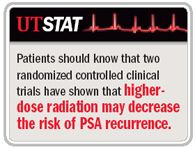Article
AUA panel: No consensus on best treatment for localized prostate cancer
Atlanta-Despite recent medical advances, no consensus exists about the optimal treatment for patients with localized prostate cancer, members of an AUA clinical guideline panel have concluded.
Atlanta-Despite recent medical advances, no consensus exists about the optimal treatment for patients with localized prostate cancer, members of an AUA clinical guideline panel have concluded.

"There is a lack of randomized studies with sufficient follow-up to accurately assess treatment impact on patient survival," said Michael S. Cookson, MD, associate professor of urologic surgery at Vanderbilt University in Nashville, TN. "Without randomized controlled trials, the panel reviewed a wide splay of outcomes and reached the conclusion that any treatment at this time is an option due to the inability to prove any single treatment superior to another."

The initial patient evaluation should include an assessment of life expectancy, overall health status, and tumor characteristics. The urologist should inform a patient with clinically localized prostate cancer about the commonly accepted initial interventions, including active surveillance, radiotherapy, and radical prostatectomy. The risks and benefits of each treatment option should be reviewed with the patient.
The panel stratified patients according to PSA values. Low-risk patients have PSA values ≤10.0 ng/mL, Gleason score ≤6, and clinical stage T1c or T2a disease. Intermediate risk is a PSA >10.0 ng/mL but <20.0 ng/mL, Gleason score 7, or clinical stage T2b. High-risk patients have PSA values >20.0 ng/mL, Gleason 8-10, or clinical stage T2c.
Treatment depends on risk

Treatment options for intermediate-risk patients consist of active surveillance, interstitial radiotherapy, external-beam radiation, and radical prostatectomy. Key points to discuss with the patient include results of a single randomized trial showing that neoadjuvant, concurrent, and adjuvant hormonal therapy of 6 months' duration prolongs survival with conventional-dose radiotherapy; findings from the one comparison of active surveillance and radical prostatectomy; and the two trials showing that higher-dose radiation might decrease the risk of PSA recurrence.
High-risk patients have the same treatment options as intermediate-risk patients do, but all of the options have recurrence rates, the panel determined. The urologist-patient discussion should include the comparison of active surveillance and radical prostatectomy and the study showing that concurrent and adjuvant hormonal therapy prolongs survival in patients who opt for radiotherapy.
Newsletter
Stay current with the latest urology news and practice-changing insights — sign up now for the essential updates every urologist needs.
















